Cheese Making
Recipes Delicious Homemade Cheese
Making cheese is an art, but also fun! If you already know how to make cheese we have a cheese making recipe or two for you. Some of these cheese making recipes are very old and have come from old English homesteading wives. If you don't know how to make cheese, then pop across to our page on How to Make Cheese.
Making cheese is not as complicated as modern instructions found on websites and in books indicate. Do you think 8000 years ago, when cheese making first started that your ancestors had ingredients like calcium chloride, annatto coloring to make the product more yellow, or red or black wax to finish it off? Of course not! And you don't have to own a cow or a homestead to make your own cheese.
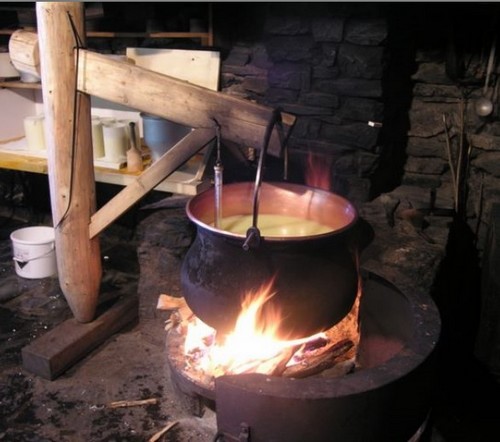
Simple Cheesemaking Recipes
For those of you who are just starting out making cheese it is best to start with the easy cheese making recipes first.
Cottage Cheese Recipe 1
Place 4 pints of organic milk heated to blood heat into a basin. Add 1 plain junket tablet crushed in a little water. Leave to set.Separate curds from whey by hanging in several layers of muslin or cheese cloth. Drain for about 12 hours. Add salt to taste and if you like parsley or chives.
Cottage Cheese Recipe 2
Place 2 pints of milk into a pot and bring to the boil. Add juice of 1 lemon. When the milk begins to curdle, remove from heat. Strain into several layers of muslin or cheese cloth. Do not squeeze but allow to drain for 12 hours hanging up.After 12 hours of draining, press under a weight so that it becomes flat and all the moisture has been removed. Using a block of wood with a gym weight works well.
This cheese and the whey can be used in the following recipe, but just go easy on the chilli powder:
Matar Panir Cheese Recipe
8 oz panir1 large onion
8 oz tomatoes
4 oz shortening
1 teaspoon tumeric
1 teaspoon ginger, powder
2 teaspoons corriander, powder
1 teaspoon chilli, powder
1 pound peas, shelled
1/2 pint whey
salt to taste
Cut the cheese into 1 inch squares. Slice the onion finely and chop the tomatoes.
Heat fat and fry the pieces of cheese till pale golden. Remove and keep aside. In the same fat fry the onion until pale golden, add spices and fry for a minute. Add tomatoes, peas, whey and salt.
Cook over a low heat until the peas are tender, add the cheese and simmer for 15 minutes.
Age is something that doesn’t matter, unless you are a cheese!
CHEESE BASICS to MAKING CHEESE
For detailed information on making
cheese, see our page How
to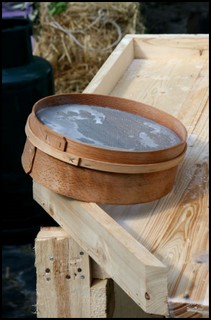 Make Cheese. Here
are the cheese making recipes for you to get on and do it, once you
know how.
However, there are some basics to cheese making that we need to
summarize, for a successful outcome.
Make Cheese. Here
are the cheese making recipes for you to get on and do it, once you
know how.
However, there are some basics to cheese making that we need to
summarize, for a successful outcome.
* All equipment and utensils should be scrupulously clean. This is not just for hygiene sake, but it could ruin the outcome of your cheese if your equipment has not been sterilized properly. This includes making sure that any detergent residues from your dishwasher, or hand washing have been totally removed before beginning.
* The most successful cheeses are made using raw milk, although it is not impossible to make cheese using store milk. However, in doing so many more additives need to be used. Therefore, if you can, use raw milk at all times.
* When using rennet always dilute it with 3-4 times its volume with cold water before adding it to the milk.
* When salt is added to the cheese make sure that it is either dairy salt, kosher salt, cheese salt or non-iodized salt. Using ordinary iodized table salt will kill or retard the growth of the starter cultures of your cheese.
CHEESE MAKING RECIPES for BUTTERMILK CROWDIE
This is a traditional Aberdeenshire cheese making recipe. When making cheese with this recipe, a delicious crowdie is made from the buttermilk. Raise the temperature of the buttermilk to 140 degrees F. Hold it at this temperature for 15 minutes, stirring continuously. Cool to 90 degrees F. Settle for 20 minutes and then run off the whey.
Ladle the remaining curd into a cheese cloth on a draining rack and tie cloth, tightening as drainage takes place. This is usually completed within 6-8 hours. When ready it should cling together when pressed in the hand.
Mix with a small quantity of good cream, and add salt at a rate of 1/4 oz. to the pound of curd. This is ready to use immediately.
CHEESE MAKING RECIPES for CARAWAY SEED CHEESE
To 6 gallons of milk, heated to blood heat, add 1 tablespoon of rennet. When curd is set, break with hand. Let it settle for 15 minutes, then pour off whey.
To the curd add 1 dessert spoonful salt, 1/4 oz caraway seeds, and 2 tablespoons of fresh cream. Stir all together, and press into cheese-press lined with muslin or cheese-cloth.
Leave for 3 days - adjusting the sides of the press if necessary when cheese sinks. Keep for 2 months before eating. This recipe for making cheese can be adjusted where, if you don't like the caraway seeds, then leave them out.
CHEESE MAKING RECIPES for CORNISH CHEESE
Place milk on stove and bring to 94 degrees F. Then cool off to 88 degrees F. before adding the rennet. You will need rennet to the following proportions when making cheese: 1 dram (3.6 ml) rennet to 2 gallons of milk, 2 dram (7.2 ml) rennet to 5 gallons of milk, 3 dram (10.8 ml) to 9 gallons of milk, 4 dram (14.4 ml) to 12 gallons of milk.
Put every 7.2 ml of rennet into 4 times as much water and pour into milk when the milk reaches 88 degrees F. Deep stir for 3 minutes, then top stir until set. Take count of the time the curd takes to set, counting from the time it starts to turn, and when it is set, leave exactly 4 times as long for the whey to rise. If setting time has taken 10 minutes, leave for 40 minutes.
Now cut the curd into 1/4 inch blocks with a long knife and leave for 10 minutes. Next, put on the stove and bring to a temperature of 98 degrees F. stirring till this has been reached. Remove from stove and leave for another 10 minutes. Then dip off the whey, take up the curd and squeeze it in a strainer cloth. Fix on a plate and put a heavy weight on top. Squeeze like this for 15 minutes and then cut into 6 large pieces. Squeeze again 3 times, for 15 minutes a time, and keep turning the pieces in between.
After this, break into small pieces and once more get the temperature up to 78 degrees F. Now mix salt in thoroughly, using 1 oz salt for very 4 pounds curd.
Put in strainer cloth and keep in mold for 2 hours. Then put into a piece of muslin or cheese cloth and leave for 24 hours. After this, butter the outside of the cheese, bandage and keep in a cool place, turning every day. Making cheese with this recipe will require about 6 weeks for the cheese to ripen.
CHEESE MAKING RECIPES for COTTAGE CHEESE
Place a jugful of sour milk in a warm place until the milk is quite thick. Add salt in the proportion of 1/2 small teaspoonful to one pint. Stir well, and place in a muslin bag. Hang it to drain overnight, press between two plates for an hour, then work up with fresh cream and shape into a pat. Making cheese with this recipe just became a whole lot easier!
CHEESE MAKING RECIPES for CROFTERS' CHEESE
This is a delicious mellow recipe and the cheese improves with keeping. Although this recipe is time consuming, it is still easy. Making cheese like this is an old English farming tradition.
Take a heavy stock pot that holds 3 1/2 gallons and fill with milk. Bring the milk - previous evening's and morning's milk - up to 85 degrees F. by sitting pot containing milk in a zinc bath of water. The water in the bath is heated by an oil stove.
When 85 degrees F. is reached add rennet in proportions of 1/2 teaspoonful mixed with equal quantities of water to the 3 1/2 gallons of milk. Remove from heat. Stir well for 5 minutes until it begins to thicken; this prevents the cream from rising to the surface. Now cover with a clean white cloth, and leave undisturbed for about an hour.
Cut the curds with a long knife, cutting the curds into sections about 1 inch apart, and then slicing horizontally until it is 1 inch square, or thereabouts.
Leave for 15 minutes to allow whey to escape. Then stir, very gently for about 10 minutes with your hand. This is to be done carefully so as not to break the curd too much. The color of the whey indicates if it is correctly done. The whey should be a clear, greeny color; if white, or appearing to still contain milk, the curd has been broken too much.
The temperature must now be raised to 98 degrees F. to cook the curd. To do this take a cupful of whey and heat it in a perfectly clean saucepan till very hot - not boiling, and add it back to the curds and whey. Continue in this way, until the temperature is 98 degrees F., taking 40 - 45 minutes to do so. The curd will now become firm, and sink to the bottom and the whey will easily drain away.
The curd is now broken with the hand into small lumps, and salt is added at the rate of 1 oz to 4 pounds of curd. Line the chessit with clean muslin or cheese-cloth, pack in the curd, cover and add a 7 lb. weight on the top. In 1 hour's time, take out and turn; then - if the cheese was put in the chessit in the morning, put in a clean cloth for in the afternoon.
Next day, wrap in clean cloth again and increase the weight, and continue to wrap in clean cloths twice a day, always reversing the position, for 3 days. The remove, bind round a strip of calico the width of the depth of the cheese; put in a cool, dry, airy place to ripen - but not in the sun.
When using evening's and morning's milk, do not skim milk and add cream separately; break up cream with skimmer.
CHEESE MAKING RECIPES for CUMBERLAND CHEESE
To make 14 lbs. of cheese, add 8 tablespoons of rennet to 8 gallons of new or separated milk heated to 90 degrees C. Add butter coloring to color the mixture and allow to set. The put it in a muslin with holes in the bottom to allow the surplus whey to escape.
Break the mixture up with the fingers, adding salt to taste. Put the muslin into a round cheese press. Change the muslin every 3rd day. Leave in the press for 2 weeks, then take out to harden.
CHEESE MAKING RECIPES for DOUBLE CREAM CHEESE
When making cheese with this recipe recipe one gallon of double cream will make 2 dozen cheese of 4 ozs. each.
Steam-heat the cream by placing a container in a pail of hot water until it reaches 60 degrees F. Add 4 tablespoonfuls of starter. Ripen for 2 hours. Ladle into a twill cotton cloth over a bowl. Gather corners of cloth and tie with string. Suspend in a cool place for a few hours.
Unfasten occasionally, and scrape cream from sides of cloth to assist drainage. When changing from liquid consistency, transfer to a closer-textured cloth.
Press with a 7 lb. weight until the cheese becomes pasty; usually within 2 hours. Carefully work in a small quantity of fine salt; 1/2 oz. per gallon. Press into special molds lined with greaseproof paper.
Can be eaten immediately.
CHEESE MAKING RECIPES for FARMHOUSE GORGONZOLA CHEESE
Warm 6 gallons of milk to blood-heat; add 1 tablespoonful of rennet and stir well. Cover the milk while setting.
In about 15 minutes, break up curds with your hand. Leave to settle, and then pour off whey. With the curd, mix 2 tablespoons of dairy salt and 1 tablespoon oatmeal.
Line press with muslin or cheese-cloth, and press curd, altering position of press as cheese sinks. Leave in press for 3 days when making cheese with this recipe.
If no cheese press is available, round cake tins with holes punched in do very well, with a round piece of wood to fit inside the top. Stones put on top of this provide the necessary weight for pressing.
Take out of muslin and place on a wooden board. Keep for 2 months before eating, turning cheese occasionally.
CHEESE MAKING RECIPES for GOATS' MILK CHEESE
The milk from the previous evening is first skimmed, the cream then being warmed by standing it in a vessel in hot water. When warm, the cream is thoroughly mixed into the morning's milk, this is then strained into the evening's milk from which the cream was skimmed. Heat to 84 degrees F., by the same method of heating the cream. Add rennet at the rate of 1 dram (3.6 ml) to each gallon of milk and stir for 5 minutes.
Cover and leave for about 3/4 hour, when the curd will break clean over the finger. Cut the curd into 1/2 inch cubes with a long knife, stir for ten minutes very gently and slowly raise the temperature to 98 degrees F.
Continue stirring for another 40 minutes or until the curd becomes springy, when the whey can be run off. Line a small cheese mold with calico and pack the curd in gently. Cover and put on 10 lb pressure for about 15 minutes. It must then be reversed in the mold and a 20 lb pressure applied for 1 hour. It is then reversed again, a clean calico put on and 30 lb. pressure applied for 4 hours. Leave all night with 5 lb. pressure, and next morning rub in a little salt.
Put in a cool, airy dairy and turn daily for 3 weeks or until thought ready.
CHEESE MAKING RECIPES for LANCASHIRE CHEESE
This cheese making recipe is beyond that of your normal housewife, due to the large quantities involved. Assuming you have 50 gallons of milk made up of 24 gallons of evening milk and 26 gallons of morning milk, thoroughly mix the two together in one container. Then heat up to 76 degrees F. Add 1 1/2 tablespoons of rennet. Mix thoroughly with the milk.
Close the lid on the container and leave for 1 hour.
Remove the lid and break up the curd, which will now have formed, with your hand. Close the lid and leave for a further 1/2 hour. By this time the whey will be ready for draining off the curd. Use the whey for pig feeding.
Drain off the whey, take a long knife and cut the curd into small squares. Place on a draining cloth in the drainer. Tie the corners of the cloth tight around the curd. Leave for 1/2 hour. Untie, cut curds into squares and break up with hands. Tie again in the cloth, tightly around the curd, adding weight by screwing the drainer down slightly. Leave another 1/2 hour.
It is now ready for another breaking-up and pressing for 1/2 hour. Repeat the process again, only add more weight this time to dry the curd thoroughly. Leave for a further 1/2 hour. Take the curd from the drainer and place in a storage tin. Leave until the following day. Wash all utensils thoroughly.
The following day, repeat the same process with the milk from the next 2 milkings.
Having obtained the curd from the second day's milkings, we now take 26 lbs. of the first day's curd and 24 lbs. from the second day's curd and place in the curd mill. Grind thoroughly together in the curd tins. Now add the salt - 5 oz and mix well into the curd. Now place in the cheese vats, which should be lined with cheese-cloth.
Place vat in the press and leave for 3 hours. Turn the vat upside down on its lid; leave for a further 3 hours. Turn over to its proper position, and increase the weight for the press. Just before retiring to bed, increase the weight again.
The morning after, turn out the cheese from the vats, put on a cover of muslin. Return to the vat, and put in press for a further 3 hours, with full pressure of press on. Turn out and place on store shelves. Turn every day for a month. The cheese should not be fully matured. The cheese should be about 48 lbs. in weight.
CHEESE MAKING RECIPES for LINCOLN CHEESE (SOFT)
This is a cheese making recipe where one can make cheese the easy way! Take 1 1/2 gallons of new milk and 2 pints of sour milk or buttermilk. Buttermilk is best if available. Heat to 70 degrees F. and add 1/2 teaspoon rennet. Leave for 2 hours to set, then cut curd and ladle into cloths to drain.
This will make about 12 cheeses, which will be ready for eating after maturing for 2 days.
CHEESE MAKING RECIPES for MOZZARELLA CHEESE
Add 2 teaspoons citric acid to 2 gallons milk. Stir. Heat to 86 degrees F. Remove from heat.
Add 1/2 teaspoon liquid rennet to 1/4 c. water. Stir it in until it has dissolved. Add the rennet/milk mixture to your milk. Stir it for about half a minute. Then let sit undisturbed for about 20 minutes. A firm curd should be formed by then, floating on the whey.
Cut up the curd with a knife. Heat slowly to 100 degrees F. (takes about 10 minutes), stirring gently. Remove from heat. Let it rest five minutes and then pour off the whey.
Place the curds in a bowl. Heat in a microwave oven for about two or three minutes (until it becomes soft and workable). Pour off the whey. Knead the cheese like bread, working in 1 teaspoon. salt. Cool and eat!
CHEESE MAKING RECIPES for NOTTINGHAM-COLWICK CHEESE
Top 1 gallon of new milk, at a temperature of 85 degrees F. add 17 drops of rennet which has been diluted with 3 times its own bulk of water. The rennet should be carefully stirred into the milk for 3 minutes, after which the vessel is covered with a lid or a cloth to retain as much heat as possible during coagulation.
While coagulation is going on, the molds should be placed on racks or a slightly sloping draining table. The molds are then well lined with butter muslin of sufficient size for the corners to reach well over the cheese, and if necessary, to hasten the process to be tied up Stilton fashion when making cheese. This is done by taking 3 corners of the cloth and binding them tightly around the 4th corner. Adjust every 10 minutes as the curd becomes dry.
The curd should be ready to ladle into the molds after 1 1/4 hours from the time the rennet was added. This is done by using a ladle or saucer. Large, clean-cut slices are made until the molds are full.
Drainage may now be left to take place of its own accord. In about 1/4 hour's time, the ends of the cloth should be folded over the top of the curd. This will cause the curd, as it drains, to fall inwards. In 10 minutes' time, - and if a quick cheese is required - take the 3 corners of the cloth and time them around the 4th. As soon as the cheese is firm, the cloth should be removed and the cheese placed on a shelf until required. 1 gallon will produce 2 cheeses.
CHEESE MAKING RECIPES for NOVICE CHEESE
This cheese making recipe shows that you really don't need all that fancy cheese equipment. Take 3 gallons of hand-skimmed milk, from 3 consecutive milkings, warmed to 80 degrees F. The add 1/2 teaspoon rennet per gallon, stirring it well into the milk. When the junket has set, cut into large squares with a knife, and put it to warm again slowly till the whey has risen well. Then clear the whey from the curd by bailing it gently with a cup, and also by pouring it off.
Now, with a milk skimmer, put the curd (with about a tablespoon of salt mixed with it) into a steamer top lined with muslin, filling the steamer to the brim with the curd, then covering the curd with a fold of the muslin. On top of this place a cake-tin pierced with holes which must be able to fit easily into the steamer, and set a heavy flat iron or weight in the center of the cake tin.
Leave this overnight for the whey to drain away. Next morning, replace the muslin with a dry piece. Next day again, take the cheese out of the steamer, wrap it in dry muslin, replace it between two boards with the weight on the top. Dry it with a rough cloth and turn it daily, until dry. If the cheese is inclined to crack, rub it with salt, and then once more rub it with a cloth to dry.
On the fourth day, bind the cheese tightly round the edge with a strip of calico or bandage. This will keep it from becoming too flat under the weight. Leave bandage on till the cheese is matured.
CHEESE MAKING RECIPES for PICKING CHEESE
Heat a quantity of raw milk to 86 degrees F. Add 1 teaspoon of rennet to each 2 gallons of milk used. Set aside in a warm place until curds form. The cut curd into cubes and drain off the whey.
Set aside the curd without salting until the next day, when it should be broken up and set outside where it can get really warm in the sun. Take it inside every night. Repeat the process of heating for at least 4 days; 7 if you want to have a really strong cheese. After the fourth day the curd will have a very strong smell.
Now salt the curd, using 1 oz. of salt to 3 lbs. curd. Pack in the chessel (wooden cheese mold) and press for at least a week to up to a month.
Remove the cheese from the mold and put a piece of cotton round it in the form of a bandage, and set on a piece of wood or slate in an airy place to dry. Daily turning of the cheese will ensure equality in the drying process.
The secret to making cheese in this way, is to make cheese during the height of the summer to get those curds really hot.
CHEESE MAKING RECIPES for PONT L'EVEQUE CHEESE
This is a variety of cheese, which, owing to its firm character, is only ready after ripening. 1/2 gallon of clean, fresh milk makes 1 cheese.
Warm the milk to 90 degrees and add 1/4 dram 0.9 ml) rennet which has been diluted with 4 times its volume of water. Stir into the milk in the usual way and leave for 50 -60 minutes.
When the curd breaks into a clean fracture over the finger, cut with an ordinary knife into 2 squares and leave for 5 minutes. Then ladle the curd into a coarse straining cloth laid over wooden frames with latticed bottoms, through which the whey may escape and cover with hot cloths.
In 15-20 minutes cut into 1 inch cubes. Cover and leave to drain. Leave until the curd is quite firm and fairly dry, which can be detected by its falling away from the side of the cloth. Care should be taken that the curd does not get too dry or it will not unite when placed in the molds.
When firm, break up the curd and fill in the molds. Place on a straw mat with a board underneath. When the mold is 1/2 full sprinkle a little salt and fill in the curd. As soon as the mold is full, place a straw mat and board on the top, and reverse the cheese. In 10 minutes turn the cheese again as before.
This should be done several times during the next few hours, and then the cheese should be left until the next day, when salt should be sprinkled all over and the cheese placed on a clean straw mat.
This should be done twice a day until the cheese is quite firm, when the mold may be removed. It is best to keep the cheese in an airy room for a few days, then remove it to the cellar. Turn the cheese daily. It should ripen in about 3-4 weeks.
CHEESE MAKING RECIPES for SHROPSHIRE SAGE CHEESE
To every 5 gallons of milk use 1 teaspoon of rennet mixed with 4 teaspoons of cold water. Strain 2 gallons of night's milk into a clean scalded wooden tub. Next morning, add 3 gallons of new milk and warm it all to 88 degrees F. Stir well, add the rennet and with a skimmer, stir it for 3 minutes. Cover and leave to set. In 30 minutes it should be a solid mass, and breaking away at the sides of the tub.
With a long knife cut the curd into 1/2 inch strips. Leave for 10 minutes and then break up carefully with the hands, stirring the whole mass carefully. Warm some of the whey and add to bring temperature up to 90 degrees F.; keep on stirring till curd falls into cubes, smooth and firm. Cover and leave for 30 minutes; curds should have shrunk into a solid mass.
Push curds to sides and drain off whey; cut curd into 6 inch cubes, leave for 10 minutes; turn over and cut again - and again leave for 10 minutes. Curd should look dry, and be slightly tough and acidic. Break up fine and add salt to taste.
Line a brawn tin with a scalded cloth, pack curd in it, put a wooden cover on the top, and then a heavy weight on that. Turn the next day and replace the weight.
Continue to turn the cheese over every day for 8 weeks before using. Chopped sage may be added to the curd, which makes a pleasant change when making cheese this way.
CHEESE MAKING RECIPES for SMALLHOLDER's CHEESE
Heat milk to 90 degrees F., add 1 teaspoon of rennet to 3 gallons of milk - diluting it with 3 times its own amount of cold water.
Deep stir for 2 minutes. Top stir until set to prevent the cream from rising.
Leave for about 50 minutes, then cut with a carving knife in 1/4 inch or 1/2 inch squares. Stir gently for 1 hour, gradually raising the temperature to 106 degrees F. by dipping off some whey, heating this to 120 degrees F. and putting it back into the curd. Repeat this 3 or 4 times, until the whole curd mass is 106 degrees F. Then run off the whey, crumble up the curd and salt; 1 oz to every 2 gallons of milk.
Put into a coarse cloth in the mold with 1 cubic weight of pressure. In the evening turn into a piece of muslin and put back into the mold and press again.
The next day take the cheese out and grease it. Bandage and put it in an airy room to ripen. Turn daily for 3-4 weeks. It is now ready to use.
CHEESE MAKING RECIPES for SUFFOLK NEW-MILK CHEESE
Take 6-7 pints of new milk still warm from the cow into an enamel bowl, 1/2 fill and egg-cup with water and add a small 1/2 teaspoon of rennet. Tip this into the warm milk and draw the spoon 2 or 3 times through it from side to side. Then leave to set.
When set, place another bowl on a table in the dairy, and spread a square of butter muslin, previously dipped in hot water, over it, then gently tip the curds into the muslin and, taking opposite corners tie them in knots, making sure that they will not slip. Putting one's hand through the loops, lift the whole thing up and suspend it from a hook in the rafters or over a broom handle placed between two chairs, with a bowl underneath to collect the drips.
Leave for 12-24 hours until all the whey has stopped dripping. Turn the whey out of the bowl, lift the curd down into the bowl and untie the knots.
Place a piece of muslin that has been dipped into hot water in the mold to line it. Ladle the curds out and place into the mold. Salt to taste. Fold the top of the muslin back over the cheese and place a 1 lb. weight over the top of the cheese.
Change the cloth day and night, making sure that you turn the cheese when you do so. This can be done by turning back the muslin, laying the clean cloth on top, and tipping the cheese out onto the hand and flipping it over. After about 3 days it should be dry enough to place on a saucer and put onto the window-sill, out of the sun to dry.
Again it should be turned over night and morning until dry when it will be ready to eat. The longer it is kept, the thicker the rind that develops. Making cheese with this recipe is very satisfying and gives good results.
CHEESE MAKING RECIPES for WENSLEYDALE CHEESE
Bring the milk to 90 degrees F. Add 1 tablespoon of rennet to 18 gallons of milk. When the milk coagulates after 30-45 minutes, break up with a wire breaker and let stand for 30 minutes.
Take the whey off and hang curds in a cheese- cloth to drip for 1 hour. Then crumble into a cheese vat with hands, but not too finely. The cheese should stand in the vat until afternoon.
Then put in cheese cloth and replace in cheese vat. Put the lid on the vat and put into the cheese press; put the weight on. Next morning turn the cheese and put back into the press. At night, take the cheese out and place it in a brine bath when making cheese in this manner.
To make the brine bath, fill the copper with water and add enough salt to the water until a raw egg will float. Put the brine into pickling tubs and when it is quite cold add the cheese. An 8 lb. cheese should remain in the brine for 3 days, turning the cheese morning and evening. Put a handful of salt on top of the cheeses every time they are turned.
After 3 days, remove from the brine, place on a shelf in an airy place, turn every day until dry.
Did you find this page helpful?
Sharing is a way of saying, "Thanks!"
Follow Us and Keep Up to Date
CHEESE MAKING SUPPLIES AND BESTSELLERS FOR CHEESE MAKING RECIPES
Add your Cheese Making Recipes Here!
We have lots of pages where you can contribute to throughout this homesteading website, as you can see from the links below. We love hearing from our readers, and hope you will be one of those we hear from too. Please share your favorite cheese making recipes here, so that other may enjoy eating them too! Just type in the form below, we will do the rest.
Share your Best Recipes with us
Do you have a great recipe? Share it! We hope that you will share your favourite family recipes with all of us, so we can build a great recipe online resource of tried and trusted recipes.







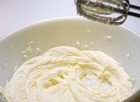
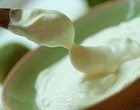
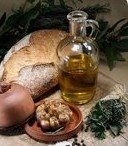
New! Comments
Do you have something of value to add? Leave me a comment in the box below.